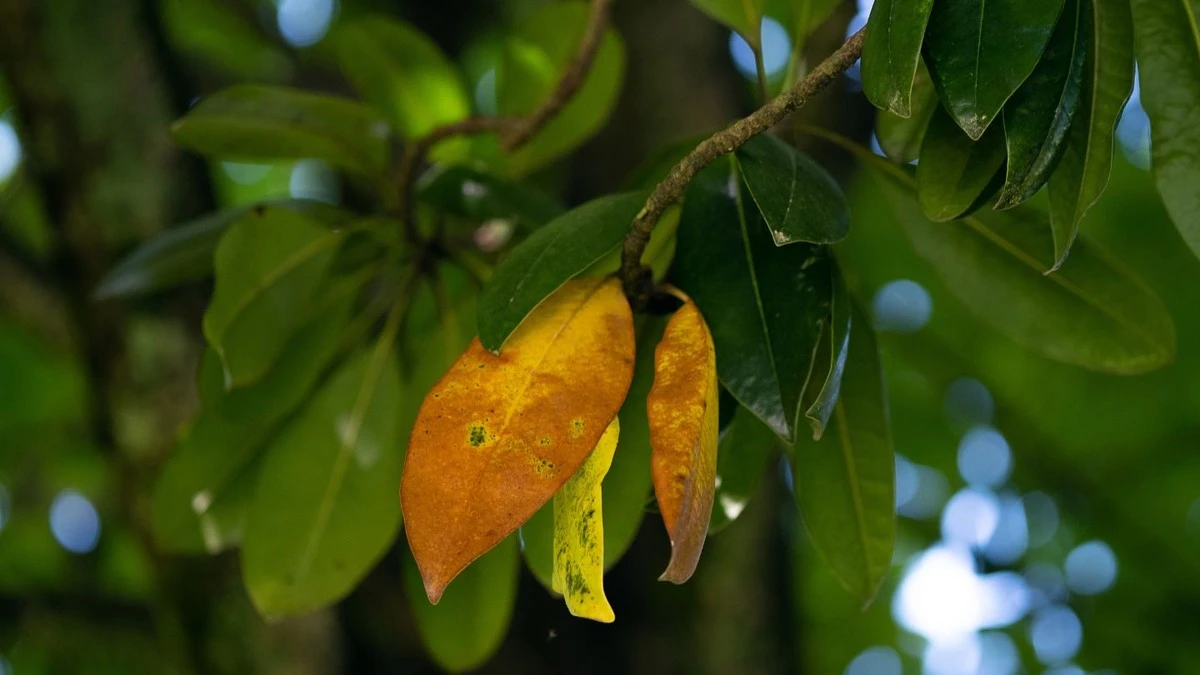A small fraction of tropical tree leaves already pass the threshold, scientists estimate, and that number could grow under worst-case climate models.
Leaves in the world’s tropical forests are approaching critical temperatures at which photosynthesis breaks down—and a fraction have likely already passed that threshold—raising alarms about the fate of these essential ecosystems under the most pessimistic projections of human-driven climate change, reports a new study.
Tropical forests are home to roughly half of known species on Earth and they play an essential role in the health and stability of the global climate. While this lush biome is known for its balmy temperatures, tropical leaves start to die off at temperatures exceeding about 46.7°C (or 116.1°F) because they can no longer perform photosynthesis, which is the basic metabolic process of converting sunlight to energy that powers plants.
Scientists led by Christopher Doughty, an associate professor in ecoinformatics at Northern Arizona University, have now discovered that about 0.01 percent of leaves in the world’s tropical forests may already surpass this critical temperature in a typical year. While that is a small number right now, the team projected that “tropical forests can withstand up to a 3.9 ± 0.5 °C increase in air temperatures before a potential tipping point in metabolic function,” an outcome that is within the range of “worst case scenario” climate models, according to a study published on Wednesday in Nature.
“We want to understand the future temperatures of tropical forests because they hold most of the world’s species” and because “tropical forests are important for their climate regulation properties,” said Doughty in a press briefing held on Monday.
“We started looking at individual leaf temperatures and what we kept seeing, and what kept popping up through multiple datasets, is a ‘long tail’ when you plot the distribution of these leaves,” he continued. “All that means is that if you look at a bunch of leaves in a tree, there’s a few that are really approaching these critical thresholds.”
Doughty and his colleagues began their research by examining equatorial forests from space with a sensor called the Ecosystem Spaceborne Thermal Radiometer Experiment on Space Station (ECOSTRESS), which has been measuring plant temperatures from the International Space Station since 2018.
The ECOSTRESS data, along with follow-up measurements from the ground, showed that tropical canopy temperatures tend to peak at around 34°C, though some regions experienced temperatures that exceeded 40°C. Because there is a surprising amount of temperature variation between the individual leaves on a single tree, the researchers estimated that about a tenth of a percent of all leaves in tropical forests are annually pushed beyond the critical threshold of 46.7°C that marks the breaking point of photosynthesis.
“We have known for a long time that when leaves reach a certain temperature, their photosynthetic machinery breaks down,” said Gregory Goldsmith, a plant physiological ecologist at Chapman University who co-authored the study, in the press briefing. “In fact, the first measurements of that were made more than 150 years ago, but this study is really the first study to establish how close tropical forest canopies may be to these limits.”
“From my perspective, this study is important because believe it or not, we don’t know terribly much about why trees die," he continued. “We know that when a tree is knocked over in a storm and loses its roots, it dies. We know how it dies when there’s a fire. But we know much less about the interactive effects of heat, drought, water, and temperature. I think this study really helps us begin to fill in the gap.”
As global temperatures continue to rise, more tropical leaves will be pushed beyond their photosynthetic capabilities, causing plants to perish. While the researchers emphasized that there is a lot of uncertainty in their models, they warned that an increase in global air temperatures of about 3.9°C could trigger a major photosynthetic meltdown for tropical forests. This estimated increase is within the range of climate models that project a future where human greenhouse gas emissions don’t begin to fall until after 2080.
On the one hand, it’s frightening to imagine that tropical forests might reach this tipping point under any climate scenario; a collapse of this critical biome would have far-reaching and catastrophic ripple effects for the world’s climate and biodiversity. That said, Doughty and his colleagues stressed that we could avert this disaster by rapidly decreasing our consumption of fossil fuels, which is the main driver of anthropogenic climate change.
“It is still within our power to decide…the fate of these critical realms of carbon, water and biodiversity,” the researchers warned in the study. “The combination of climate change and local deforestation may already be placing the hottest tropical forest regions close to, or even beyond, a critical thermal threshold.”
“Therefore, our results suggest that the combination of ambitious climate change mitigation goals and reduced deforestation can ensure that these important realms of carbon, water and biodiversity stay below thermally critical thresholds,” they concluded.
Ah, I didn’t even have “photosynthesis just fucking up and quits” on my climate disaster bingo card yet.
I’m honestly worried that we (as in us humans as a species) are not putting enough thought into climate survival. Most talk is currently about climate mitigation, but it’s becoming abundantly clear we need to start thinking much more about how the hell we’re going to deal with all the changes that are going to happen regardless of what we do
If you want to spend a few nights awake, you should read about the planet Venus, its current climate, and the climate it might have had.
Oh yeah I’ve done that at some point. Would not recommend.
I’m only halfway (if even that) kidding when I say that maybe all the unprecedented changes we’re seeing right now are a black swan event that’s essentially us doing a speedrun to a Venus-like hellscape
I keep dreaming about masses of thirsty people storming cities and the people inside trying to fight them off… i really hope I’m wrong…
Honestly it’s probably going to be worse than what anyone wants to think
Great, another second order effect that makes the problem worse faster.
Cooooool. Cool cool cool cool cool. Cool. So cool.
Actually it’s getting warmer.
Hoooot. Hot hot hot hot hot hot.
We will likely find a way to alter their DNA to cope with the heat long before we will change the situation. Sorry plants.
I think we are att he point where some sort of engineering of our own planet really will be necessary.
I hope some sort of cooling is viable, like that marine cloud brightening, but I’m also wondering if we are past the point of having the luxury to worry about invasive species, and we need to just grow what we can where we can. The purple flowers taking over iceland is an interesting case for discussion. Personally I want to save species that are threatened by the spread of invasive species, but if that invasive species has other overwhelmingly positive effects… It’s hard to say they are a problem that has to be removed.







